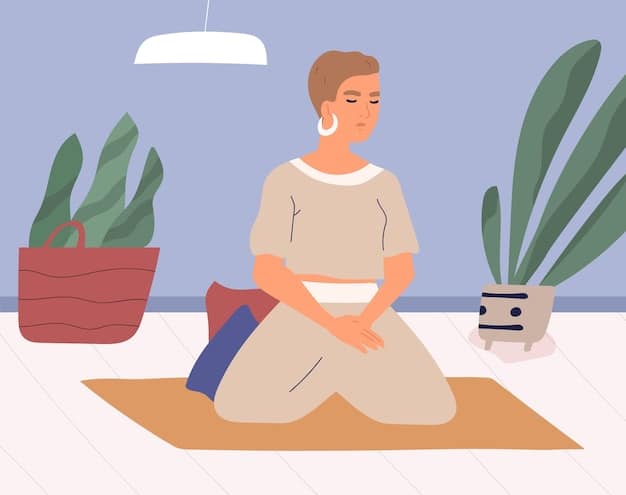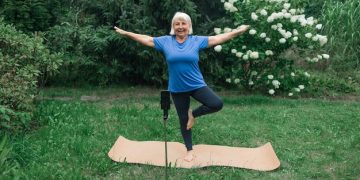Mindfulness Meditation for Daily Well-being: A Guide

Incorporating mindfulness meditation into your daily routine is a transformative practice that cultivates present moment awareness, effectively reducing stress and enhancing overall mental wellness through intentional focus on breath and sensory experiences.
In our increasingly chaotic world, finding moments of calm and clarity can feel like an elusive quest. Yet, an ancient practice offers a timeless solution: mindfulness meditation. Learning How to Incorporate Mindfulness Meditation into Your Daily Routine for Improved Mental Wellbeing is not merely about carving out a few minutes each day; it is about cultivating a profound shift in how we perceive and interact with the world around us.
Understanding Mindfulness Meditation
Mindfulness meditation is a practice that involves focusing one’s attention on the present moment, acknowledging and accepting one’s feelings, thoughts, and bodily sensations without judgment. It’s about being fully present, aware of where we are and what we’re doing, rather than being caught up in rumination about the past or anxieties about the future.
This practice has roots in ancient Buddhist traditions but has been secularized and widely adopted in modern Western contexts, primarily for its scientifically proven benefits on mental and physical health. The core of mindfulness isn’t to empty the mind, but rather to observe it, creating a space between our thoughts and our reactions.
The Core Principles of Mindfulness
Mindfulness hinges on several foundational principles that guide its practice and foster a deeper connection to the present moment. These principles, though seemingly simple, require consistent application to yield their transformative effects on mental well-being.
- Non-judging: Approaching thoughts and feelings with an attitude of open curiosity, neither condemning nor praising them.
- Patience: Understanding that change and growth happen naturally over time, rather than forcing outcomes.
- Beginner’s Mind: Seeing things as if for the first time, approaching each moment with fresh eyes and an open heart.
Another crucial element is non-striving. Instead of trying to achieve a particular state or outcome, the practitioner simply observes what is, allowing experiences to unfold naturally. This paradoxically leads to deeper states of calm and insight. Letting go of attachments to specific outcomes in meditation helps cultivate a sense of inner freedom, freeing the mind from the constant push and pull of desires and aversions. This gentle approach allows the mind to settle and reveal its inherent clarity.
Distinguishing Mindfulness from Other Meditation Forms
While often grouped under the umbrella of “meditation,” mindfulness has distinct characteristics. Unlike concentration meditation, where the focus is narrowed to a single object (like a candle flame or a mantra), mindfulness involves a broader, open awareness. It’s about noticing the full landscape of internal and external experiences as they arise without getting caught up in them. This broader scope allows for a more comprehensive engagement with one’s inner world, promoting a deeper sense of self-awareness and emotional regulation. The flexibility of mindfulness makes it highly adaptable to various situations, from formal seated practice to active engagement in daily tasks.
It’s not about achieving a blank mind, which is a common misconception. Instead, it’s about observing thoughts and emotions as they appear, like clouds passing across the sky, without attaching to them. This detached observation helps to disrupt automatic negative thought patterns and reduce their emotional charge. By consistently practicing this separation, individuals can gain greater control over their emotional responses and improve overall mental resilience.
Scientific Backing for Mindfulness
The rise in popularity of mindfulness meditation is not just a trend; it’s heavily supported by a growing body of scientific research. Studies have explored its impact on various aspects of mental well-being, from stress reduction to improved cognitive function, providing a robust empirical foundation for its widespread adoption. This scientific validation has moved mindfulness from esoteric practice to a credible therapeutic tool.
Impact on Stress and Anxiety
One of the most well-documented benefits of mindfulness is its profound effect on reducing stress and anxiety. Research, often using techniques like fMRI scans, shows that regular mindfulness practice can alter brain structures associated with emotional regulation. The amygdala, often called the brain’s “fear center,” tends to shrink with consistent mindfulness, while the prefrontal cortex, responsible for executive functions like decision-making and emotional control, can thicken. This physiological shift contributes to a more balanced and less reactive emotional state.
Furthermore, mindfulness helps individuals develop a healthier relationship with stressful thoughts. Instead of being overwhelmed by them, practitioners learn to observe their thoughts and feelings without judgment, creating a mental distance that prevents them from spiraling into anxiety. This ability to detach from distressing thoughts is critical for managing chronic stress and preventing anxiety disorders, offering a proactive approach to mental health.
Enhancing Emotional Regulation
Mindfulness meditation cultivates a heightened awareness of emotions as they arise, allowing individuals to recognize their feelings without being swept away by them. This increased emotional literacy is crucial for developing better emotional regulation skills. Rather than reacting impulsively to difficult emotions, practitioners learn to pause, observe, and choose a more measured response. This pause creates a vital space between stimulus and reaction, fostering greater self-control and thoughtful engagement.
This process is particularly beneficial for managing anger, sadness, and frustration. By regularly observing their emotional landscape, individuals become more adept at identifying triggers and understanding the transient nature of feelings. This understanding promotes a sense of inner stability, reducing emotional volatility and improving interpersonal relationships. The ability to navigate complex emotional states with greater ease contributes significantly to overall mental resilience and equanimity.
Cognitive Benefits and Focus
Beyond emotional well-being, mindfulness meditation has been shown to improve various cognitive functions. Regular practice can enhance attention span, improve working memory, and boost cognitive flexibility. By training the mind to remain focused on the present moment, even amidst distractions, mindfulness strengthens neural pathways associated with sustained attention. This improved focus isn’t just about sitting still; it translates into better performance in daily tasks, from work projects to personal interactions.
Moreover, mindfulness can foster greater creativity and problem-solving abilities. When the mind is less cluttered by internal noise and rumination, it becomes more open to novel ideas and different perspectives. This mental clarity can lead to innovative solutions and a more adaptable approach to challenges. The practice nurtures a state of calm alertness, which is conducive to insightful thinking and effective decision-making.
Preparing for Your Mindfulness Journey
Embarking on a mindfulness journey doesn’t require elaborate preparations or special equipment. It primarily calls for a willingness to dedicate time and an open mind. However, setting yourself up for success involves considering a few practical aspects that can significantly enhance your experience and consistency.

Creating a Conducive Environment
While mindfulness can be practiced anywhere, having a designated space, even a small corner, can signal to your mind that it’s time to focus. Choose a quiet area where you are unlikely to be disturbed. Eliminate distractions by turning off notifications, televisions, and other potential interruptions. The goal is to create an environment that supports your ability to turn inward and connect with the present moment without external interference.
Consider adding elements that promote a sense of calm, such as dim lighting, a comfortable cushion, or a subtle, pleasant aroma from an essential oil diffuser. While these are not strictly necessary, they can contribute to a more profound and enjoyable meditation experience. The consistency of your environment can help condition your mind to enter a state of mindfulness more readily, making your practice more effective over time. Even a small, uncluttered space can become your sanctuary.
Mindset and Expectations
Perhaps more important than the physical environment is your mental preparation. Approach mindfulness with a “beginner’s mind” and without rigid expectations. It’s easy to get frustrated if your mind wanders or if you don’t immediately feel a sense of profound calm. Remember, mindfulness is a practice, not a performance. There is no “right” or “wrong” way to experience it. Rather than aiming for an empty mind, aim for awareness of whatever arises.
- Be patient: Results don’t appear overnight; progress is gradual.
- Be kind to yourself: Acknowledge distractions without judgment and gently redirect your focus.
- Embrace impermanence: Thoughts and feelings are transient; observe them and let them pass.
Understanding that distractions are a normal part of the process is liberating. Every time your mind wanders and you gently bring it back to your anchor (like your breath), you are strengthening your mindfulness “muscle.” This consistent, gentle effort is what truly builds resilience and presence in your daily life, transforming casual observation into a profound practice.
Techniques for Daily Mindfulness Integration
Once you understand the basics, the next step is seamlessly weaving mindfulness into the fabric of your everyday life. This doesn’t mean you need to dedicate hours to formal meditation; rather, it’s about micro-moments of awareness that accumulate throughout the day, enhancing your overall well-being. These techniques are designed to be adaptable, fitting into various schedules and lifestyles.
Formal Meditation Practices (Short Sessions)
Even a few minutes of formal meditation can make a significant difference. Start with 5-10 minute sessions. Find a comfortable seated position, close your eyes gently, and focus on your breath. Notice the sensation of air entering and leaving your body. When your mind wanders, gently bring your attention back to your breath. This simple practice builds the foundation for greater mindfulness in all areas of your life.
Consider using guided meditations, especially when starting out. Many apps and online resources offer short, structured meditations that can help you maintain focus and learn new techniques. The consistency of these short, disciplined sessions reinforces the neural pathways associated with mindfulness, making it easier to access states of calm and presence throughout your non-meditative moments. Over time, these brief periods of formal practice will spill over into the rest of your day.
Mindful Breathing Exercises
Your breath is an ever-present anchor to the present moment. Throughout the day, take short “mindful breath breaks.” For example, before answering a phone call or starting a new task, take three slow, deep breaths, fully aware of each inhalation and exhalation. This simple act can disrupt automatic reactions and bring you back to a state of calm and clarity. It’s a quick reset button for your nervous system.
Try the 4-7-8 breathing technique: inhale for 4 counts, hold for 7, and exhale slowly for 8 counts. This specific rhythm helps activate the parasympathetic nervous system, promoting relaxation and reducing stress. Practicing mindful breathing consistently can lower your baseline stress levels, making you less susceptible to the negative impacts of daily pressures. This accessible tool requires no special equipment and can be performed anywhere.
Mindful Eating
Eating is a daily ritual that offers ample opportunities for mindfulness. Instead of rushing through meals, take time to notice the food. Observe its colors, textures, and aromas. Chew slowly, savoring each bite. Pay attention to the sensations in your mouth, the flavors, and how your body responds to the nourishment.
Mindful eating not only enhances your enjoyment but also improves digestion and helps you recognize your body’s signals of hunger and fullness, potentially supporting healthier eating habits. This practice transforms a mundane activity into a sensory experience, grounding you in the present moment. By engaging fully with your meal, you consume not just food, but also cultivate a deeper connection to your body and its rhythms.
Mindful Walking
Whether you’re walking to work or strolling in a park, transform your walk into a mindful exercise. Pay attention to the sensation of your feet touching the ground, the rhythm of your steps, and the movement of your body. Notice the sights, sounds, and smells around you without getting caught up in judging or labeling them. This practice helps to ground you and shift your awareness from internal chatter to external reality.
Don’t try to clear your mind; simply observe. If thoughts arise, acknowledge them gently and return your attention to the physical sensations of walking. Mindful walking is an excellent way to combine physical activity with mental presence, offering a dual benefit for both body and mind. It turns a routine activity into an opportunity for restorative awareness, fostering a deeper appreciation for your surroundings and your own physical presence.
Overcoming Common Challenges
While the benefits of mindfulness meditation are clear, the path to incorporating it into daily life is not always smooth. Many practitioners encounter hurdles that can disrupt consistency and lead to frustration. Recognizing these common challenges and equipping yourself with strategies to navigate them is crucial for sustaining your mindfulness journey and truly reaping its rewards.
Dealing with a Wandering Mind
The most frequent challenge in meditation is a wandering mind. It’s important to understand that a busy mind is not a sign of failure; it’s a normal function of the human brain. The key is not to eliminate thoughts, but to change your relationship with them. When you notice your mind has strayed, gently acknowledge the thought without judgment, and then calmly redirect your attention back to your chosen anchor, usually your breath.
Think of it as training a puppy: you don’t scold it for wandering; you gently lead it back to where you want it to be. Each time your mind wanders and you bring it back, you are strengthening your attention muscle. This consistent, compassionate redirection is the essence of mindfulness practice and builds mental resilience over time, fostering a greater ability to remain present even amidst internal distractions.
Finding Time in a Busy Schedule
In today’s fast-paced world, finding even a few minutes for mindfulness can seem daunting. The solution isn’t necessarily to carve out large blocks of time, but to integrate short, mindful moments throughout your day. Start with just 5 minutes in the morning or before bed. Even a few mindful breaths before a meeting or during your commute can make a difference.

Consider using transition times creatively: waiting for coffee, standing in line, or during a few quiet moments at your desk. These micro-practices accumulate, building a stronger foundation for mindfulness without demanding a major schedule overhaul. Consistency, even in short bursts, is far more effective than sporadic long sessions. This practical approach makes mindfulness accessible to everyone, regardless of their daily demands.
Managing Expectations
Many beginners expect immediate profound calm or enlightenment. This unrealistic expectation can lead to frustration and abandonment of the practice. Mindfulness is not about suppressing thoughts or forcing relaxation; it’s about observing what is present, whether it’s calm, agitation, or boredom. Embrace the process, not just the outcome.
Understand that some days will feel more “successful” than others. Some meditations might feel restless, others peaceful. All are part of the journey. Cultivate an attitude of non-judgment and self-compassion. The beauty of mindfulness lies in its ability to meet you exactly where you are, rather than demanding a perfect state. This realistic perspective helps sustain motivation and fosters a healthier relationship with the practice itself.
Sustaining Your Mindfulness Journey
Integrating mindfulness into your daily routine is the first step; sustaining it over the long term requires dedication, adaptability, and a commitment to continuous learning. Just like any beneficial habit, consistency is key, but so is the flexibility to adjust your practice as your life circumstances evolve. This ongoing engagement ensures that mindfulness remains a vital tool for your mental well-being.
Building Consistency and Routine
The habit of mindfulness, like any other, thrives on consistency. Try to set a specific time each day for your formal practice, even if it’s just 5 to 10 minutes. This regular appointment signals to your brain that mindfulness is a priority and helps establish a consistent rhythm. Placing your meditation cushion or creating a designated quiet space can serve as visual cues, gently reminding you to engage in your practice.
Beyond formal sessions, aim for consistent moments of informal mindfulness throughout your day. Whether it’s mindfully sipping your morning coffee, paying attention to the sounds during your commute, or feeling your feet on the ground as you walk, these small acts accumulate. The cumulative effect of these consistent micro-practices is what truly re-wires your brain over time, making mindfulness a natural part of your daily awareness.
Integrating Mindfulness into Various Activities
Mindfulness isn’t confined to a meditation cushion; it’s a way of being. Look for opportunities to bring mindful awareness to various everyday activities. Turn chores into opportunities for presence: wash dishes mindfully, feeling the water, seeing the soap bubbles, and noticing the tactile sensations. Mindful listening during conversations, fully absorbing what others are saying without formulating your response, can deepen your relationships.
Even challenging situations can become opportunities for mindfulness. When faced with stress or strong emotions, pause and simply notice the physical sensations and thoughts without reacting immediately. This integration truly transforms your daily life, making every moment a potential practice ground for enhanced awareness and emotional regulation. It’s about living mindfully, not just meditating.
Resources and Community
You don’t have to navigate your mindfulness journey alone. There’s a wealth of resources available, both online and offline, that can support your practice. Meditation apps, online courses, and local meditation centers offer guided practices, workshops, and opportunities to connect with a community of like-minded individuals. Sharing experiences and insights with others can be incredibly motivating and provide valuable perspectives.
Consider exploring different teachers or traditions if one approach doesn’t resonate initially. The meditation landscape is diverse, and finding a style or teacher that connects with you personally can significantly enhance your commitment. Joining a local mindfulness group or an online forum provides a sense of accountability and shared purpose, reinforcing your dedication to consistent practice. Continuous learning and community support are powerful allies in sustaining a lifelong mindfulness journey.
| Key Practice | Brief Description |
|---|---|
| 🧘♀️ Formal Sessions | Dedicate 5-10 minutes daily to seated meditation, focusing on breath. |
| 🌬️ Mindful Breathing | Take short, intentional breath breaks throughout your day to reset. |
| 🍎 Mindful Eating | Savor meals by noticing taste, texture, and aroma, without distraction. |
| 🚶♀️ Mindful Walking | Pay attention to physical sensations and surroundings during walks. |
Frequently Asked Questions About Mindfulness Meditation
▼
Beginners can start with as little as 5-10 minutes per day. The key is consistency, not duration. Gradually increase your meditation time as you feel more comfortable and centered. Even a few minutes of focused presence can yield significant benefits for mental well-being over time.
▼
Absolutely! Mindfulness can be incorporated into almost any daily activity. Mindful walking, eating, listening, and even dishwashing are all forms of informal mindfulness. The essence is bringing non-judgmental awareness to the present moment, regardless of the activity, enhancing presence and reducing mind-wandering.
▼
A wandering mind is completely normal, even for experienced meditators. The practice isn’t about stopping thoughts, but gently noticing when your mind has strayed and kindly bringing your attention back to your anchor, such as your breath. Each time you do this, you strengthen your capacity for presence and focus.
▼
While mindfulness has roots in Buddhist traditions, modern mindfulness practices are often secular and are adopted for their scientifically proven health benefits. Many schools, hospitals, and corporations use mindfulness techniques without any religious affiliation, focusing solely on its mental and emotional well-being aspects.
▼
Immediate benefits can include a reduction in stress and anxiety, improved emotional regulation, enhanced focus, and a greater sense of calm. Over time, these benefits deepen, leading to more resilient mental health, better sleep, and an improved overall quality of life by fostering a more engaged and present existence.
Conclusion
Incorporating mindfulness meditation into your daily routine is not just a trend; it is a powerful, evidence-based strategy for cultivating improved mental well-being. From reducing stress to enhancing cognitive function and fostering emotional resilience, the benefits are profound and far-reaching. By creating a conducive environment, practicing short formal sessions, and integrating mindful awareness into everyday activities like eating and walking, you can gradually weave presence into the fabric of your life. Overcoming challenges such as a wandering mind or a busy schedule requires patience and adaptability, but the consistent, compassionate effort yields incredible returns. This journey is a testament to the idea that true well-being stems from our ability to be fully present, transforming ordinary moments into extraordinary opportunities for peace and clarity. By embracing these practices, you unlock a sustainable path to a healthier, more balanced mind.





